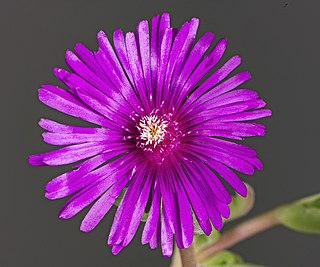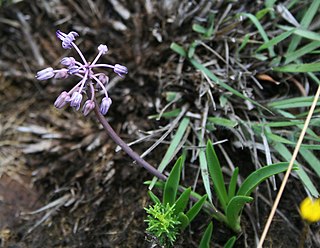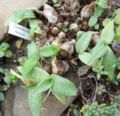Muthi is a traditional medicine practice in Southern Africa as far north as Lake Tanganyika.

Scilloideae is a subfamily of bulbous plants within the family Asparagaceae. Scilloideae is sometimes treated as a separate family Hyacinthaceae, named after the genus Hyacinthus. Scilloideae or Hyacinthaceae include many familiar garden plants such as Hyacinthus (hyacinths), Hyacinthoides (bluebells), Muscari and Scilla and Puschkinia. Some are important as cut flowers.

Delosperma cooperi, the trailing Iceplant, hardy iceplant or pink carpet, is a dwarf perennial plant native to South Africa. It forms a dense lawn with abundant, long-lasting flowers. It reaches sizes of approximately 10–15 cm (4–6 in) tall, with fleshy leaves that are linear and simple and can grow up to 1.5 inches long and a trailing stem that hangs down. These fleshy roots help provide the ability for the plants to recover and grow rapidly if a disturbance has occurred.

Ledebouria is a genus of African bulbous perennial herbs in the Asparagus family, Asparagaceae, subfamily Scilloideae. Most members were previously part of the genus Scilla. A number of species are grown by cacti and succulent enthusiasts for their patterned leaves.

Delosperma is a genus of around 170 species of succulent plants, formerly included in Mesembryanthemum in the family Aizoaceae. It was defined by English botanist N. E. Brown in 1925. The genus is common in southern and eastern Africa, with a few species in Madagascar, Reunion island, Yemen and Saudi Arabia. Delosperma species, as do most Aizoaceae, have hygrochastic capsules, opening and closing as they wet and dry.

Dierama is a genus of flowering plants in the family Iridaceae. Common names include hairbells, angel's fishing rod, fairybells, and wandflowers in English and grasklokkies in Afrikaans. They are native to Africa, with most occurring in the southern regions of the continent. The center of diversity is the province of KwaZulu-Natal in eastern South Africa.

Haworthia cymbiformis is a species of the genus Haworthia in the family Asphodelaceae, endemic to the Eastern Cape Province in South Africa.

Ledebouria socialis, the silver squill, wood hyacinth, or leopard lily, is a geophytic species of bulbous perennial plant native to the Eastern Cape Province of South Africa. It was first described by John Gilbert Baker as Scilla socialis in 1870. John Peter Jessop later revised the genus Scilla and split off several species, reclassifying Scilla socialis into the genus Ledebouria in 1970. It is often cultivated and grows well with minimal care.

Ledebouria floribunda is a species of flowering plant in the Asparagaceae family. It is a bulbous geophyte native to South Africa, Eswatini, and Lesotho.

Ledebouria revoluta, the south Indian squill, is a flowering plant species in the genus Ledebouria found in Southern Africa and India.

Haworthia cooperi is a diverse and varied species of the genus Haworthia in the family Asphodelaceae, endemic to the Eastern Cape Province in South Africa.

Haworthia mucronata is a species of the genus Haworthia in the family Asphodelaceae, endemic to the Little Karoo region, in the Western Cape Province of South Africa.

Aloe cooperi, also known as Cooper's aloe and as iPutumane in Zulu, is a succulent species that is endemic to Southern Africa. It has significant cultural and economic value to the Zulu people of South Africa.

Adromischus cooperi is a species of succulent plant from the family Crassulaceae. The genus name Adromischus comes from ancient Greek adros and mischos, and the species name from Thomas Cooper. The plant is endemic to the Eastern Cape of South Africa.

Ledebouria ovatifolia, the flat-leaved African hyacinth, is a widespread species of bulbous flowering plant in the family Asparagaceae, native to South Africa and Lesotho. With its highly variable spotted leaves and attractive flowers, it is popular with succulent enthusiasts, although it is not, strictly speaking, a succulent.
Ledebouria ovalifolia is a species of bulbous flowering plant in the family Asparagaceae, native to the Cape Provinces of South Africa.

Ledebouria minima is a species of bulbous flowering plant in the family Asparagaceae, native to South Africa.

Albuca cooperi is a species of small, perennial, bulbous plant in the asparagus family.
Nymphaea nouchali var. ovalifolia is a variety of the water lily species Nymphaea nouchali Burm.f. native to the region spanning from West Tanzania to South Africa.
















